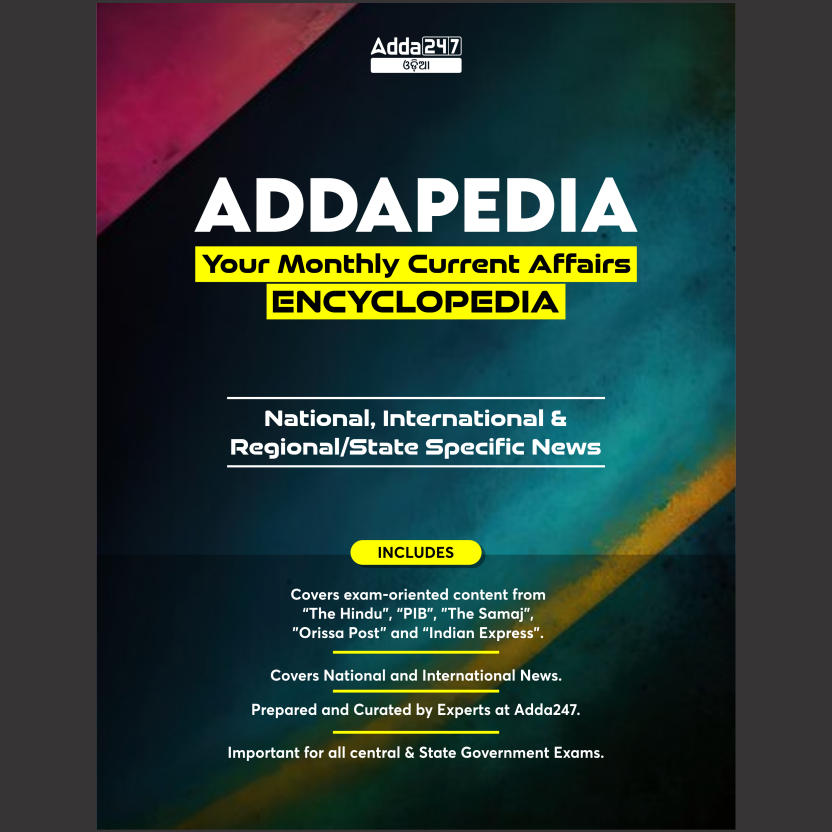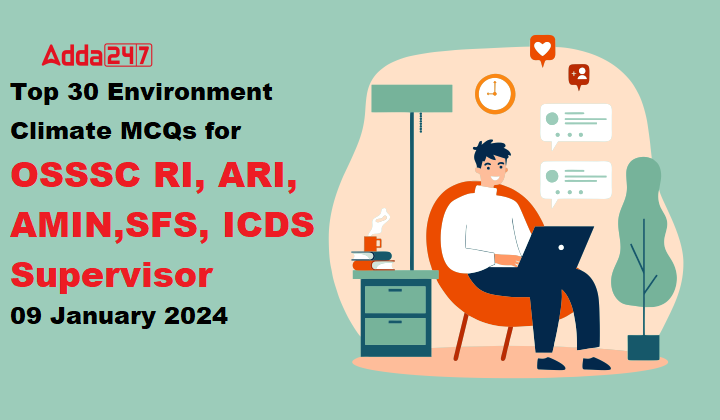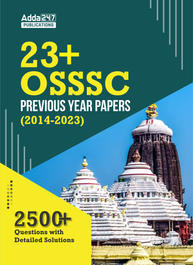The OSSSC RI, ARI, AMIN,SFS, ICDS Supervisor exam, is crucial for candidates aspiring to make a career in Revenue Inspector, Assistant Revenue Inspector, or Amin roles. One significant aspect of this examination is the Environment and Climate section. This article aims to provide candidates with a comprehensive set of 30 Multiple Choice Questions (MCQs) related to Environment and Climate, accompanied by answers at a moderate difficulty level.
Top 30 Environment and Climate Multiple Choice Questions for OSSSC RI, ARI, AMIN,SFS, ICDS Supervisor Exam
These 30 Environment and Climate MCQs provide a comprehensive overview of key concepts that candidates should be familiar with for the OSSSC RI, ARI, AMIN,SFS, ICDS Supervisor exam. Good luck with your preparations!
- What is the primary greenhouse gas responsible for global warming?
a) Carbon Monoxide
b) Methane
c) Nitrous Oxide
d) Carbon Dioxide
Answer: d) Carbon Dioxide - Which of the following is a renewable source of energy?
a) Coal
b) Natural Gas
c) Solar Power
d) Nuclear Energy
Answer: c) Solar Power - Which layer of the atmosphere protects life on Earth by absorbing ultraviolet solar radiation?
a) Exosphere
b) Mesosphere
c) Stratosphere
d) Troposphere
Answer: c) Stratosphere - Deforestation is primarily responsible for an increase in:
a) Oxygen levels
b) Carbon dioxide and other greenhouse gases
c) Ozone depletion
d) Nitrogen levels
Answer: b) Carbon dioxide and other greenhouse gases - What is the major cause of soil erosion?
a) Wind
b) Water
c) Human activity
d) Volcanic activity
Answer: b) Water - The Montreal Protocol aims to protect the ozone layer by phasing out the use of:
a) Ozone-Depleting Substances (ODS)/Chlorofluorocarbons (CFCs)
b) Methane
c) Carbon monoxide
d) Nitrogen oxides
Answer: a) Ozone-Depleting Substances (ODS)/Chlorofluorocarbons (CFCs) - Which international agreement focuses on reducing greenhouse gas emissions to combat climate change?
a) Kyoto Protocol
b) Paris Agreement
c) Rio Declaration
d) Basel Convention
Answer: b) Paris Agreement - The term “Biodiversity” refers to:
a) The number of animal species in an area
b) The variety of life on Earth
c) The population of a specific species
d) The diversity of ecosystems in a region
Answer: b) The variety of life on Earth - Acid rain is caused by the emission of pollutants like:
a) Carbon dioxide
b) Sulfur dioxide and nitrogen oxides
c) Methane
d) Ozone
Answer: b) Sulfur dioxide and nitrogen oxides - Which gas is responsible for the “hole” in the ozone layer?
a) Oxygen
b) Methane
c) Chlorofluorocarbons (CFCs)
d) Carbon monoxide
Answer: c) Chlorofluorocarbons (CFCs)
- What is the main driver of desertification?
a) Deforestation
b) Overgrazing
c) Urbanization
d) Volcanic activity
Answer: b) Overgrazing - The term “El Niño” is associated with changes in:
a) Ocean currents and sea surface temperatures
b) Atmospheric pressure
c) Rainfall patterns
d) Wind patterns
Answer: a) Ocean currents and sea surface temperatures - Which of the following is a non-renewable source of energy?
a) Wind
b) Biomass
c) Natural Gas
d) Geothermal
Answer: c) Natural Gas - The concept of the “Ecological Footprint” is related to:
a) Carbon offsetting
b) Conservation of endangered species
c) Human impact on the environment
d) Sustainable agriculture
Answer: c) Human impact on the environment - What is the primary source of indoor air pollution in households using solid fuels for cooking?
a) Carbon dioxide
b) Nitrogen oxides
c) Carbon monoxide
d) Ozone
Answer: c) Carbon monoxide - The process of converting waste materials into reusable materials is known as:
a) Recycling
b) Composting
c) Incineration
d) Landfilling
Answer: a) Recycling - Which of the following is a greenhouse gas that is also released during the decomposition of organic waste in landfills?
a) Methane
b) Nitrous Oxide
c) Ozone
d) Hydrofluorocarbons (HFCs)
Answer: a) Methane - What is the primary cause of coral bleaching in marine ecosystems?
a) Overfishing
b) Ocean acidification
c) Pollution
d) Global warming
Answer: d) Global warming - The “Three R’s” in environmental conservation stand for:
a) Reduce, Recycle, Restore
b) Reuse, Recycle, Recover
c) Reduce, Reuse, Recycle
d) Restore, Replenish, Recycle
Answer: c) Reduce, Reuse, Recycle - The ozone layer is located in which part of the Earth’s atmosphere?
a) Troposphere
b) Stratosphere
c) Mesosphere
d) Exosphere
Answer: b) Stratosphere
- Which of the following is a characteristic of a sustainable ecosystem?
a) Rapid depletion of natural resources
b) High levels of pollution
c) Biodiversity conservation
d) Excessive use of non-renewable energy
Answer: c) Biodiversity conservation - The process of converting sunlight into energy in plants is known as:
a) Respiration
b) Photosynthesis
c) Transpiration
d) Germination
Answer: b) Photosynthesis - The term “Carbon footprint” refers to:
a) The amount of carbon dioxide emitted by a person, organization, or activity
b) The carbon content in the soil
c) The size of a carbon molecule
d) The carbon concentration in the atmosphere
Answer: a) The amount of carbon dioxide emitted by a person, organization, or activity - What is the primary cause of the “hole” in the ozone layer over Antarctica?
a) Industrial pollution
b) Nuclear testing
c) Ultraviolet radiation
d) Depletion of ozone-depleting substances
Answer: d) Depletion of ozone-depleting substances - Which of the following is a sustainable agricultural practice?
a) Monoculture
b) Agrochemical overuse
c) Crop rotation
d) Deforestation
Answer: c) Crop rotation - The concept of “Carbon sequestration” is associated with:
a) The release of carbon dioxide from fossil fuels
b) The storage of carbon in forests and soil
c) The emission of carbon monoxide from vehicles
d) The extraction of carbon from the atmosphere
Answer: b) The storage of carbon in forests and soil - The Kyoto Protocol aims to address the issue of:
a) Ozone depletion
b) Deforestation
c) Acid rain
d) Greenhouse gas emissions
Answer: d) Greenhouse gas emissions - Which of the following is a direct impact of climate change on oceans?
a) Increased salinity
b) Ocean acidification
c) Decreased sea levels
d) Expansion of sea ice
Answer: b) Ocean acidification - The term “Eutrophication” is associated with:
a) Soil erosion
b) Air pollution
c) Water pollution due to excess nutrients
d) Deforestation
Answer: c) Water pollution due to excess nutrients - Which international organization plays a key role in promoting global environmental sustainability?
a) World Bank
b) International Monetary Fund (IMF)
c) United Nations Environment Programme (UNEP)
d) World Health Organization (WHO)
Answer: c) United Nations Environment Programme (UNEP)









